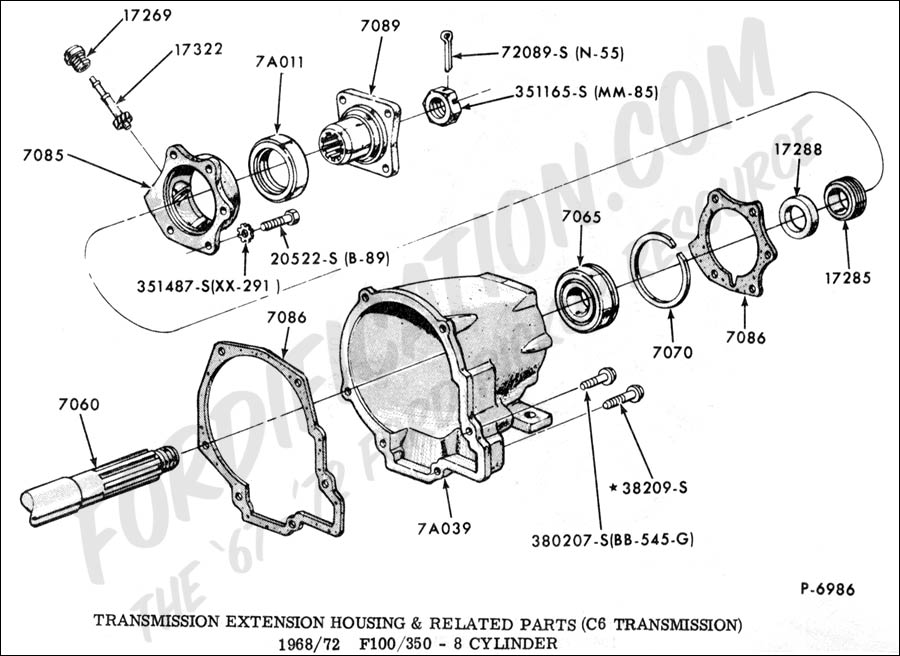1969 Ranger Driveshaft Removal
Moderators: FORDification, 70_F100
-
wartmeister
- New Member

- Posts: 37
- Joined: Tue Jun 07, 2016 3:51 pm
 1969 Ranger Driveshaft Removal
1969 Ranger Driveshaft Removal
Plan is to remove the drive shaft so I can pull the engine and transmission together. I am trying to remove the driveshaft from the rear end so I can then pull it from the transmission. I have removed the nuts from the U-bolts on the drive shaft, but unsure how to proceed after that. The U-bolts won't even come completely out because they are blocked by the end of the driveshaft. Appreciate any advice.
-
59yblockf100
- New Member

- Posts: 234
- Joined: Fri Aug 19, 2016 4:45 pm
Re: 1969 Ranger Driveshaft Removal
its a automatic?.make sure tires are blocked,put transmission in neutral,tap on end of drive shaft or put a long flat wrench or bar in a opening in front of the nut the holds yoke on rear axle and pry toward transmission work it back and forth it will come off,ujoint caps sit on a lip so it sits tight in place,
-
hazelnut
- 100% FORDified!

- Posts: 1928
- Joined: Fri Oct 23, 2009 1:06 am
- Location: Williamsburg,Virginia
Re: 1969 Ranger Driveshaft Removal
I would also put a yoke into the back of the transmission to keep all the trans fluid from draining out when you pull the motor and trans. Saves a lot of clean up afterwards.
-
wartmeister
- New Member

- Posts: 37
- Joined: Tue Jun 07, 2016 3:51 pm
Re: 1969 Ranger Driveshaft Removal
I guess my inexperience shows. Manual says to "remove" the driveshaft...when it should say pull/slide it out of the rear end and then out of the transmission. Got it done. Thanks.
- HIO Silver
- 100% FORDified!

- Posts: 1970
- Joined: Sat Jul 23, 2011 11:31 pm
- Location: Devil's Mountain, CA
Re: 1969 Ranger Driveshaft Removal
Remove the U-bolts (straps) at the rear axle pinion. Use a screwdriver to pry them out.
The driveshaft typically has a slip yoke or a slipped joint section where it is splined. Compress the driveshaft and it should clear the pinion yoke to allow its removal.
The driveshaft typically has a slip yoke or a slipped joint section where it is splined. Compress the driveshaft and it should clear the pinion yoke to allow its removal.
70 F100 LB 2WD, 360FE, E-Street EFI, TKO-500, 76K original miles.. follow my rebuild: The Lo-Buck Bumpside
71 F250 LB, 2WD, 360FE, T18, PS, PB, D60 with 4.11s
73 F100 SB 4WD, 390FE, NP435, +4 on 35s
01 Ferrari 360 Spider F1
01 F150 SuperCrew Lariat 4WD
01 PT Cruiser Limited (DD)
68 Mustang
65 Mustang
71 F250 LB, 2WD, 360FE, T18, PS, PB, D60 with 4.11s
73 F100 SB 4WD, 390FE, NP435, +4 on 35s
01 Ferrari 360 Spider F1
01 F150 SuperCrew Lariat 4WD
01 PT Cruiser Limited (DD)
68 Mustang
65 Mustang
-
dpson
- New Member

- Posts: 11
- Joined: Tue Aug 16, 2016 3:00 am
- Location: Montpelier, VT
Re: 1969 Ranger Driveshaft Removal

Okay you guys have me confused, I just replaced the transmission rear seal (aka extension housing seal) on a 1969 long box Ranger, 360 V8 with C6 auto and as can be seen in the above diagram there is no slip yoke at the back of the transmission. There is "fixed" (bolt on) yoke (7089) secured by a large nut and to remove the 2 piece drive shaft you need to unbolt the center support bearing in order to slide the driveshaft rearward, so that it can be unbolted from the fixed yoke at the back of the transmission. The "slip" coupling that allows it to move rearward is just behind the center support bearing. There is no need to remove or unbolt anything at the differential (rear end), unless you want to remove it completely. One piece of advice, when you loosen the center support bearing and push the driveshaft rearward, be sure not allow the front section of the driveshaft to slip out of the rear section, otherwise it will need to be put back together in the exact same position, otherwise the two sections of driveshaft will be "out-of-phase", which can cause vibration.
Also if you are replacing the rear transmission seal (7A011), the one listed in most online catalogues, such as Rock Auto, Advanced Auto, etc. is incorrect. The correct one for the C6 with bolt on yoke is a National (Timkin) 410308. The seal housing is narrower than the original Ford seal, but it fits and functions just fine.